Safe Administration of Medications Workbook - 1807NRS Assessment
VerifiedAdded on 2022/12/15
|15
|3615
|224
Homework Assignment
AI Summary
This homework assignment focuses on medication safety, covering various aspects essential for healthcare professionals. It begins by outlining the regulatory bodies governing medication in Australia and their roles in market assessment, licensing, and monitoring. The assignment then delves into the four phases of clinical trials, emphasizing drug safety, effectiveness, and post-marketing surveillance. Key pharmacological concepts, including pharmacokinetics and pharmacodynamics, are explained, highlighting their significance in understanding drug behavior within the body. Specific examples, such as the sublingual administration of Glyceryl Trinitrate, are discussed, along with the importance of patient education. The assignment also explores the roles and responsibilities of healthcare professionals (nurses, doctors, and pharmacists) in ensuring safe medication use. It further analyzes the medication cycle, identifying potential causes of medication errors at each stage and offering preventive strategies. The assignment also examines the person-centered and system approaches to error management, including the Swiss cheese model, to understand the factors contributing to medication errors and implement effective preventive measures. Lastly, the assignment provides an in-depth analysis of the factors contributing to medication errors and offers a comprehensive preventive strategy for each factor.
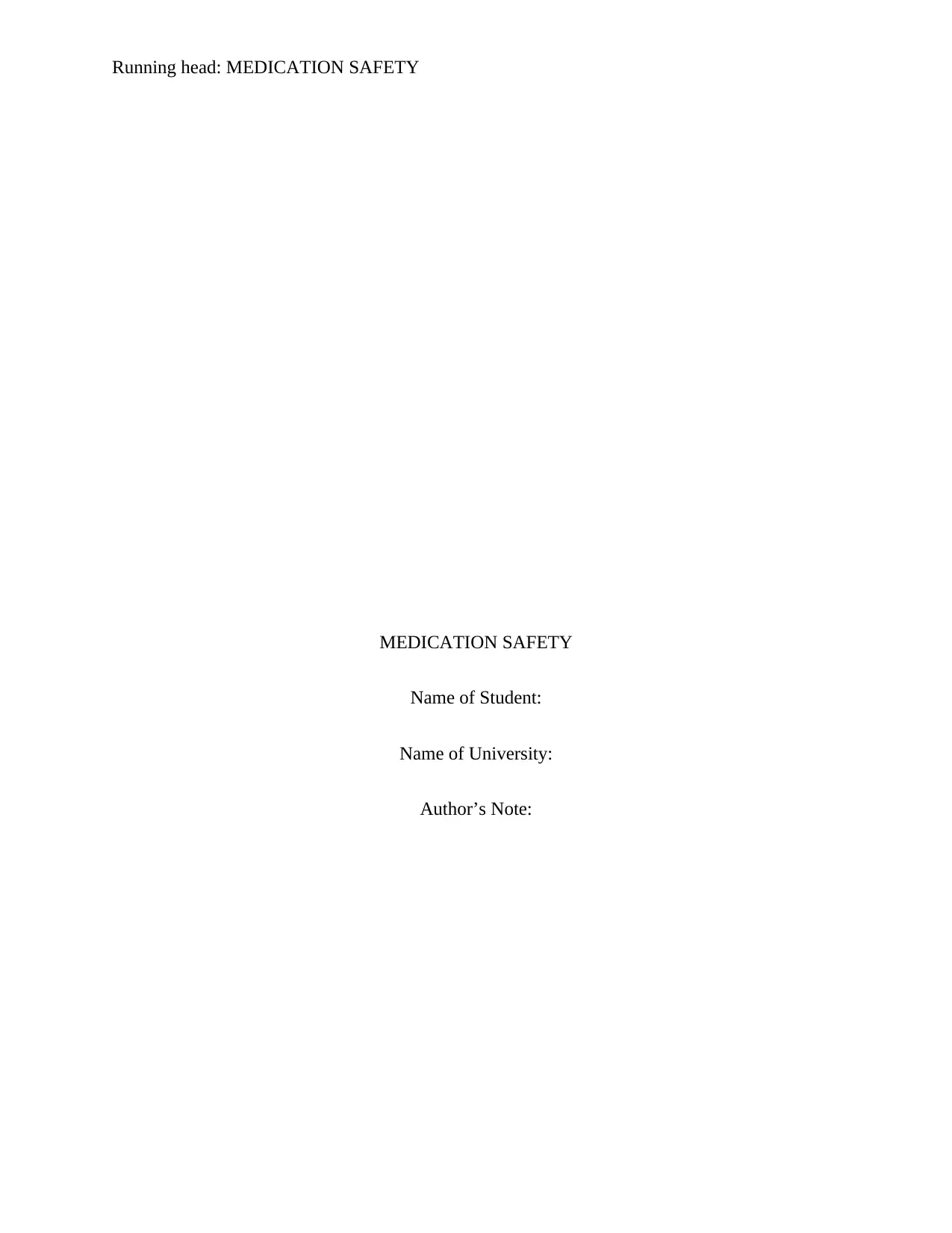
Running head: MEDICATION SAFETY
MEDICATION SAFETY
Name of Student:
Name of University:
Author’s Note:
MEDICATION SAFETY
Name of Student:
Name of University:
Author’s Note:
Paraphrase This Document
Need a fresh take? Get an instant paraphrase of this document with our AI Paraphraser
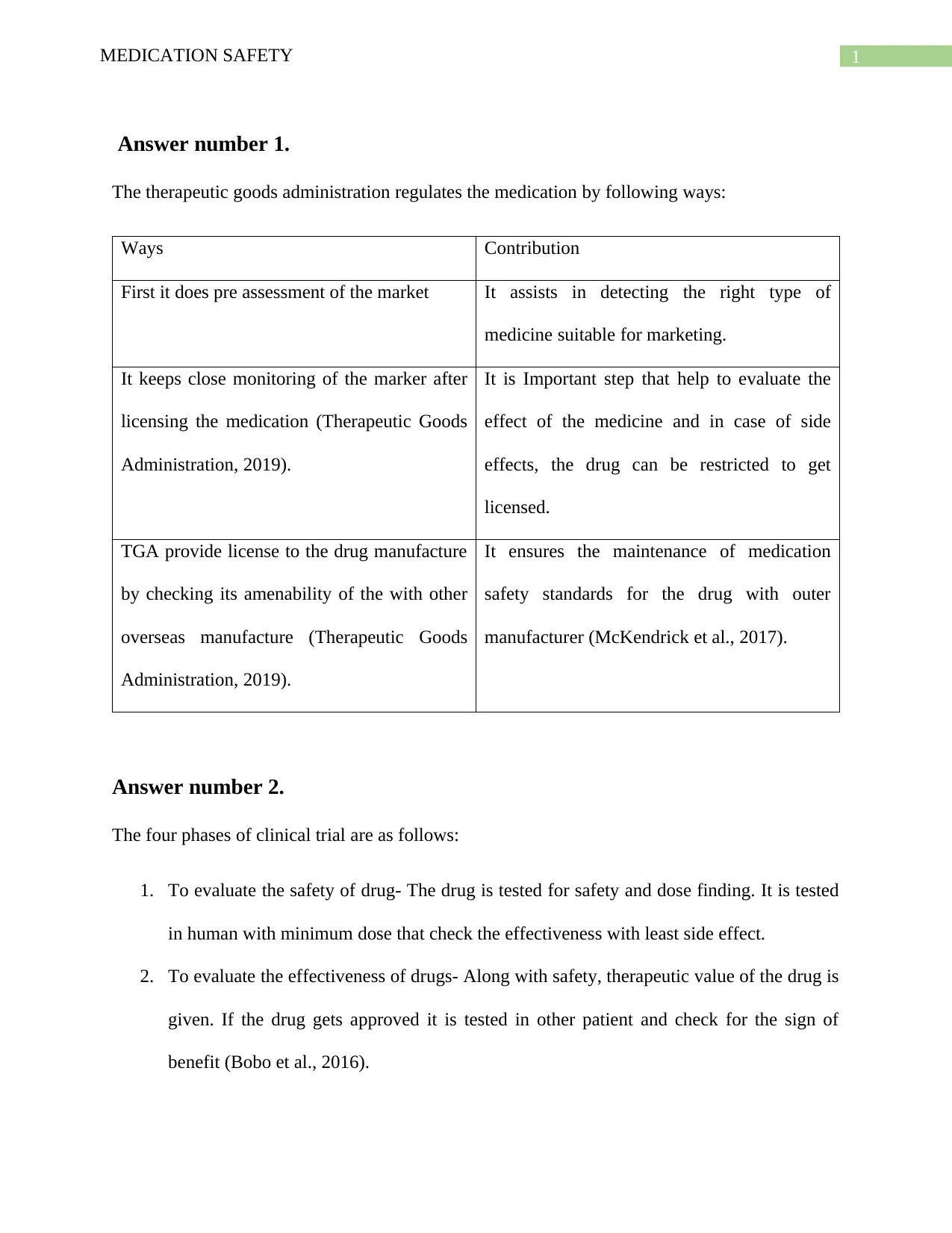
1MEDICATION SAFETY
Answer number 1.
The therapeutic goods administration regulates the medication by following ways:
Ways Contribution
First it does pre assessment of the market It assists in detecting the right type of
medicine suitable for marketing.
It keeps close monitoring of the marker after
licensing the medication (Therapeutic Goods
Administration, 2019).
It is Important step that help to evaluate the
effect of the medicine and in case of side
effects, the drug can be restricted to get
licensed.
TGA provide license to the drug manufacture
by checking its amenability of the with other
overseas manufacture (Therapeutic Goods
Administration, 2019).
It ensures the maintenance of medication
safety standards for the drug with outer
manufacturer (McKendrick et al., 2017).
Answer number 2.
The four phases of clinical trial are as follows:
1. To evaluate the safety of drug- The drug is tested for safety and dose finding. It is tested
in human with minimum dose that check the effectiveness with least side effect.
2. To evaluate the effectiveness of drugs- Along with safety, therapeutic value of the drug is
given. If the drug gets approved it is tested in other patient and check for the sign of
benefit (Bobo et al., 2016).
Answer number 1.
The therapeutic goods administration regulates the medication by following ways:
Ways Contribution
First it does pre assessment of the market It assists in detecting the right type of
medicine suitable for marketing.
It keeps close monitoring of the marker after
licensing the medication (Therapeutic Goods
Administration, 2019).
It is Important step that help to evaluate the
effect of the medicine and in case of side
effects, the drug can be restricted to get
licensed.
TGA provide license to the drug manufacture
by checking its amenability of the with other
overseas manufacture (Therapeutic Goods
Administration, 2019).
It ensures the maintenance of medication
safety standards for the drug with outer
manufacturer (McKendrick et al., 2017).
Answer number 2.
The four phases of clinical trial are as follows:
1. To evaluate the safety of drug- The drug is tested for safety and dose finding. It is tested
in human with minimum dose that check the effectiveness with least side effect.
2. To evaluate the effectiveness of drugs- Along with safety, therapeutic value of the drug is
given. If the drug gets approved it is tested in other patient and check for the sign of
benefit (Bobo et al., 2016).
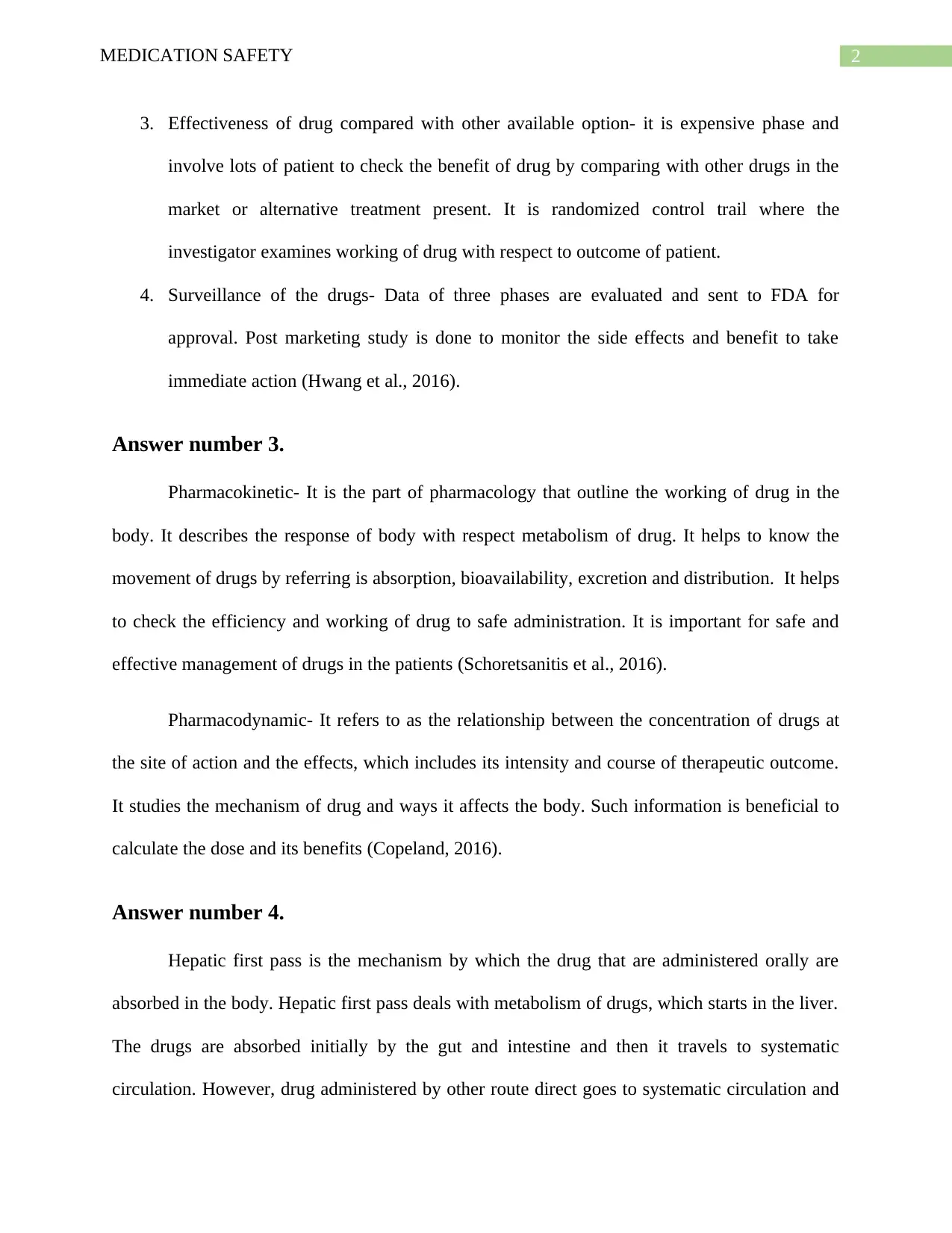
2MEDICATION SAFETY
3. Effectiveness of drug compared with other available option- it is expensive phase and
involve lots of patient to check the benefit of drug by comparing with other drugs in the
market or alternative treatment present. It is randomized control trail where the
investigator examines working of drug with respect to outcome of patient.
4. Surveillance of the drugs- Data of three phases are evaluated and sent to FDA for
approval. Post marketing study is done to monitor the side effects and benefit to take
immediate action (Hwang et al., 2016).
Answer number 3.
Pharmacokinetic- It is the part of pharmacology that outline the working of drug in the
body. It describes the response of body with respect metabolism of drug. It helps to know the
movement of drugs by referring is absorption, bioavailability, excretion and distribution. It helps
to check the efficiency and working of drug to safe administration. It is important for safe and
effective management of drugs in the patients (Schoretsanitis et al., 2016).
Pharmacodynamic- It refers to as the relationship between the concentration of drugs at
the site of action and the effects, which includes its intensity and course of therapeutic outcome.
It studies the mechanism of drug and ways it affects the body. Such information is beneficial to
calculate the dose and its benefits (Copeland, 2016).
Answer number 4.
Hepatic first pass is the mechanism by which the drug that are administered orally are
absorbed in the body. Hepatic first pass deals with metabolism of drugs, which starts in the liver.
The drugs are absorbed initially by the gut and intestine and then it travels to systematic
circulation. However, drug administered by other route direct goes to systematic circulation and
3. Effectiveness of drug compared with other available option- it is expensive phase and
involve lots of patient to check the benefit of drug by comparing with other drugs in the
market or alternative treatment present. It is randomized control trail where the
investigator examines working of drug with respect to outcome of patient.
4. Surveillance of the drugs- Data of three phases are evaluated and sent to FDA for
approval. Post marketing study is done to monitor the side effects and benefit to take
immediate action (Hwang et al., 2016).
Answer number 3.
Pharmacokinetic- It is the part of pharmacology that outline the working of drug in the
body. It describes the response of body with respect metabolism of drug. It helps to know the
movement of drugs by referring is absorption, bioavailability, excretion and distribution. It helps
to check the efficiency and working of drug to safe administration. It is important for safe and
effective management of drugs in the patients (Schoretsanitis et al., 2016).
Pharmacodynamic- It refers to as the relationship between the concentration of drugs at
the site of action and the effects, which includes its intensity and course of therapeutic outcome.
It studies the mechanism of drug and ways it affects the body. Such information is beneficial to
calculate the dose and its benefits (Copeland, 2016).
Answer number 4.
Hepatic first pass is the mechanism by which the drug that are administered orally are
absorbed in the body. Hepatic first pass deals with metabolism of drugs, which starts in the liver.
The drugs are absorbed initially by the gut and intestine and then it travels to systematic
circulation. However, drug administered by other route direct goes to systematic circulation and
⊘ This is a preview!⊘
Do you want full access?
Subscribe today to unlock all pages.

Trusted by 1+ million students worldwide
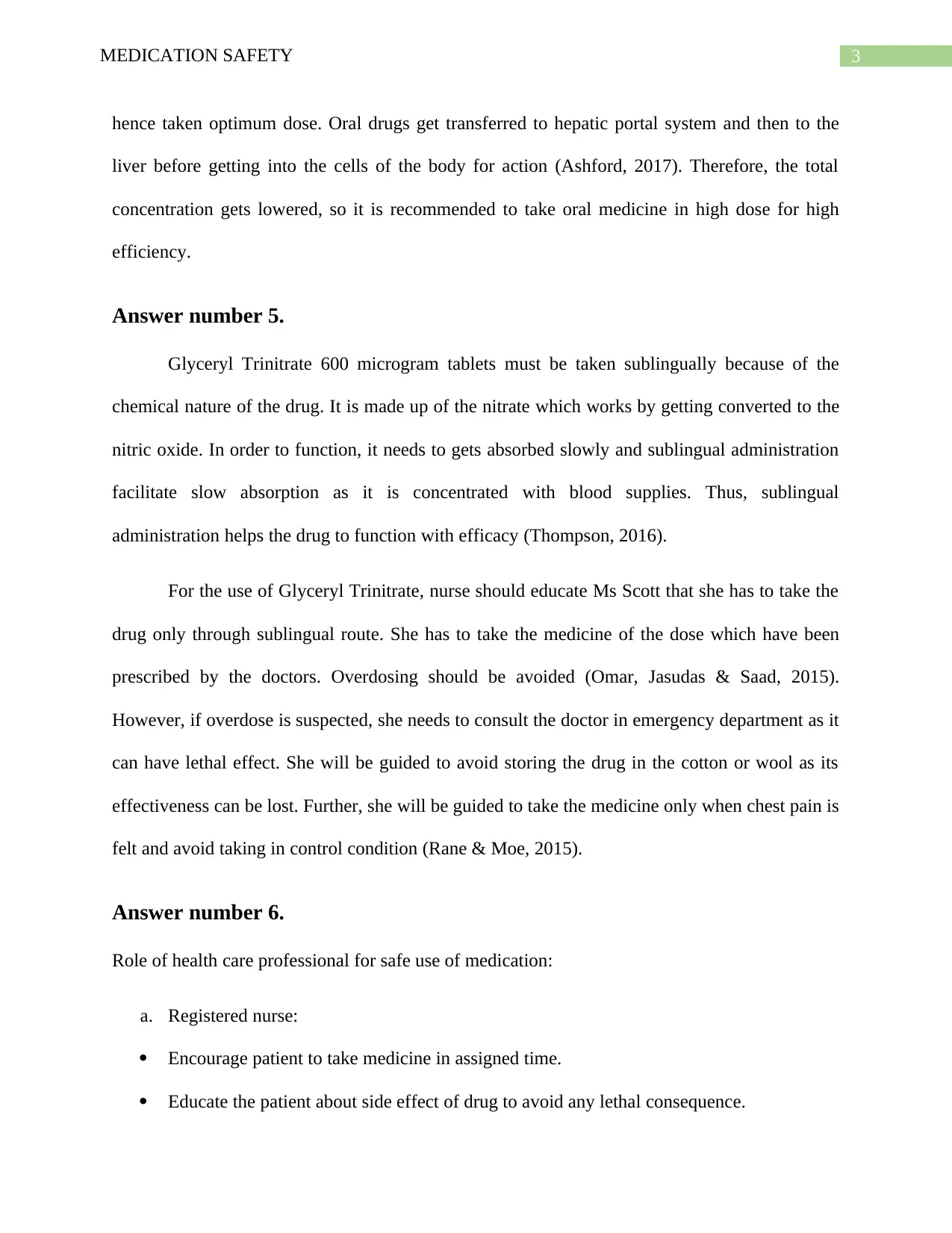
3MEDICATION SAFETY
hence taken optimum dose. Oral drugs get transferred to hepatic portal system and then to the
liver before getting into the cells of the body for action (Ashford, 2017). Therefore, the total
concentration gets lowered, so it is recommended to take oral medicine in high dose for high
efficiency.
Answer number 5.
Glyceryl Trinitrate 600 microgram tablets must be taken sublingually because of the
chemical nature of the drug. It is made up of the nitrate which works by getting converted to the
nitric oxide. In order to function, it needs to gets absorbed slowly and sublingual administration
facilitate slow absorption as it is concentrated with blood supplies. Thus, sublingual
administration helps the drug to function with efficacy (Thompson, 2016).
For the use of Glyceryl Trinitrate, nurse should educate Ms Scott that she has to take the
drug only through sublingual route. She has to take the medicine of the dose which have been
prescribed by the doctors. Overdosing should be avoided (Omar, Jasudas & Saad, 2015).
However, if overdose is suspected, she needs to consult the doctor in emergency department as it
can have lethal effect. She will be guided to avoid storing the drug in the cotton or wool as its
effectiveness can be lost. Further, she will be guided to take the medicine only when chest pain is
felt and avoid taking in control condition (Rane & Moe, 2015).
Answer number 6.
Role of health care professional for safe use of medication:
a. Registered nurse:
Encourage patient to take medicine in assigned time.
Educate the patient about side effect of drug to avoid any lethal consequence.
hence taken optimum dose. Oral drugs get transferred to hepatic portal system and then to the
liver before getting into the cells of the body for action (Ashford, 2017). Therefore, the total
concentration gets lowered, so it is recommended to take oral medicine in high dose for high
efficiency.
Answer number 5.
Glyceryl Trinitrate 600 microgram tablets must be taken sublingually because of the
chemical nature of the drug. It is made up of the nitrate which works by getting converted to the
nitric oxide. In order to function, it needs to gets absorbed slowly and sublingual administration
facilitate slow absorption as it is concentrated with blood supplies. Thus, sublingual
administration helps the drug to function with efficacy (Thompson, 2016).
For the use of Glyceryl Trinitrate, nurse should educate Ms Scott that she has to take the
drug only through sublingual route. She has to take the medicine of the dose which have been
prescribed by the doctors. Overdosing should be avoided (Omar, Jasudas & Saad, 2015).
However, if overdose is suspected, she needs to consult the doctor in emergency department as it
can have lethal effect. She will be guided to avoid storing the drug in the cotton or wool as its
effectiveness can be lost. Further, she will be guided to take the medicine only when chest pain is
felt and avoid taking in control condition (Rane & Moe, 2015).
Answer number 6.
Role of health care professional for safe use of medication:
a. Registered nurse:
Encourage patient to take medicine in assigned time.
Educate the patient about side effect of drug to avoid any lethal consequence.
Paraphrase This Document
Need a fresh take? Get an instant paraphrase of this document with our AI Paraphraser
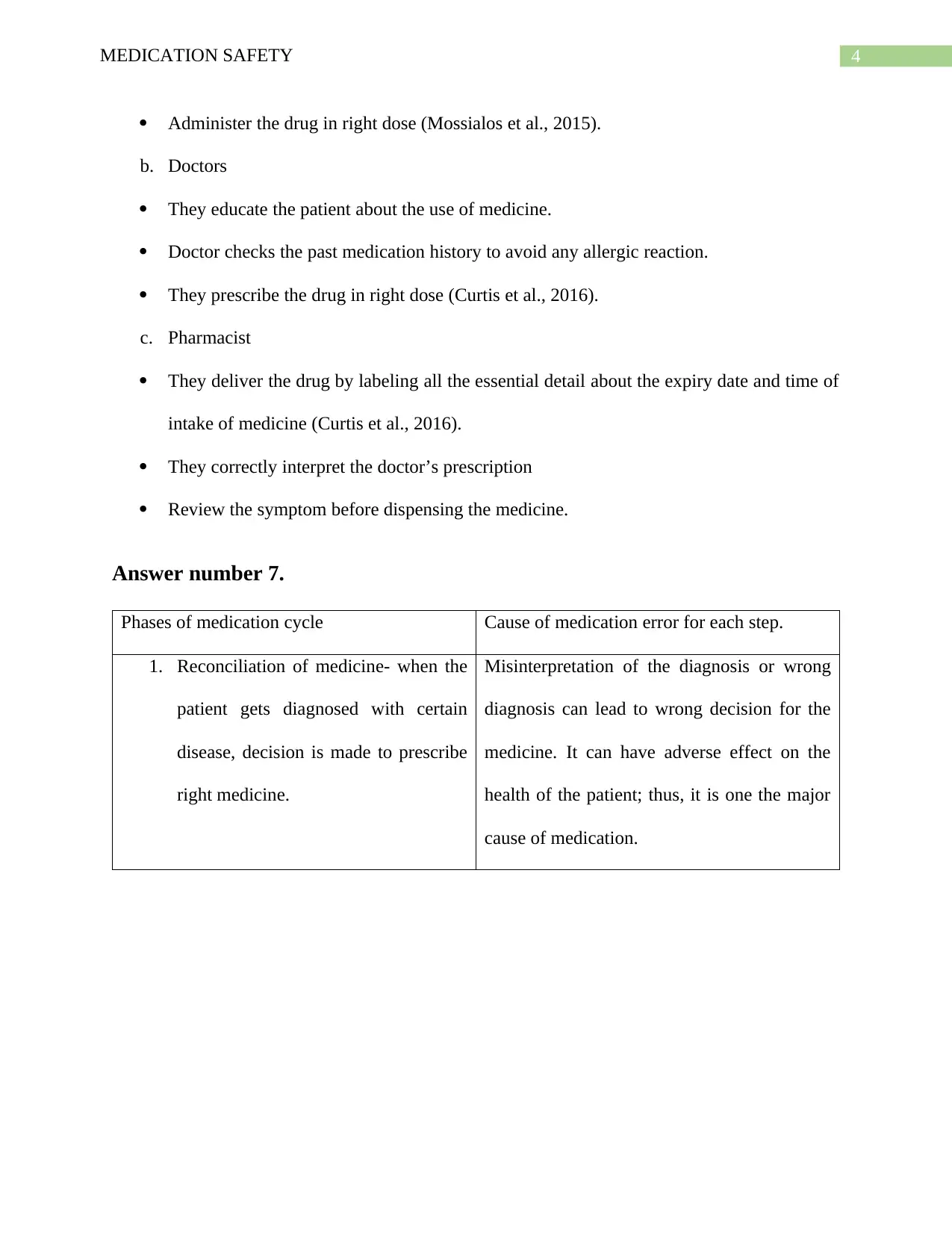
4MEDICATION SAFETY
Administer the drug in right dose (Mossialos et al., 2015).
b. Doctors
They educate the patient about the use of medicine.
Doctor checks the past medication history to avoid any allergic reaction.
They prescribe the drug in right dose (Curtis et al., 2016).
c. Pharmacist
They deliver the drug by labeling all the essential detail about the expiry date and time of
intake of medicine (Curtis et al., 2016).
They correctly interpret the doctor’s prescription
Review the symptom before dispensing the medicine.
Answer number 7.
Phases of medication cycle Cause of medication error for each step.
1. Reconciliation of medicine- when the
patient gets diagnosed with certain
disease, decision is made to prescribe
right medicine.
Misinterpretation of the diagnosis or wrong
diagnosis can lead to wrong decision for the
medicine. It can have adverse effect on the
health of the patient; thus, it is one the major
cause of medication.
Administer the drug in right dose (Mossialos et al., 2015).
b. Doctors
They educate the patient about the use of medicine.
Doctor checks the past medication history to avoid any allergic reaction.
They prescribe the drug in right dose (Curtis et al., 2016).
c. Pharmacist
They deliver the drug by labeling all the essential detail about the expiry date and time of
intake of medicine (Curtis et al., 2016).
They correctly interpret the doctor’s prescription
Review the symptom before dispensing the medicine.
Answer number 7.
Phases of medication cycle Cause of medication error for each step.
1. Reconciliation of medicine- when the
patient gets diagnosed with certain
disease, decision is made to prescribe
right medicine.
Misinterpretation of the diagnosis or wrong
diagnosis can lead to wrong decision for the
medicine. It can have adverse effect on the
health of the patient; thus, it is one the major
cause of medication.
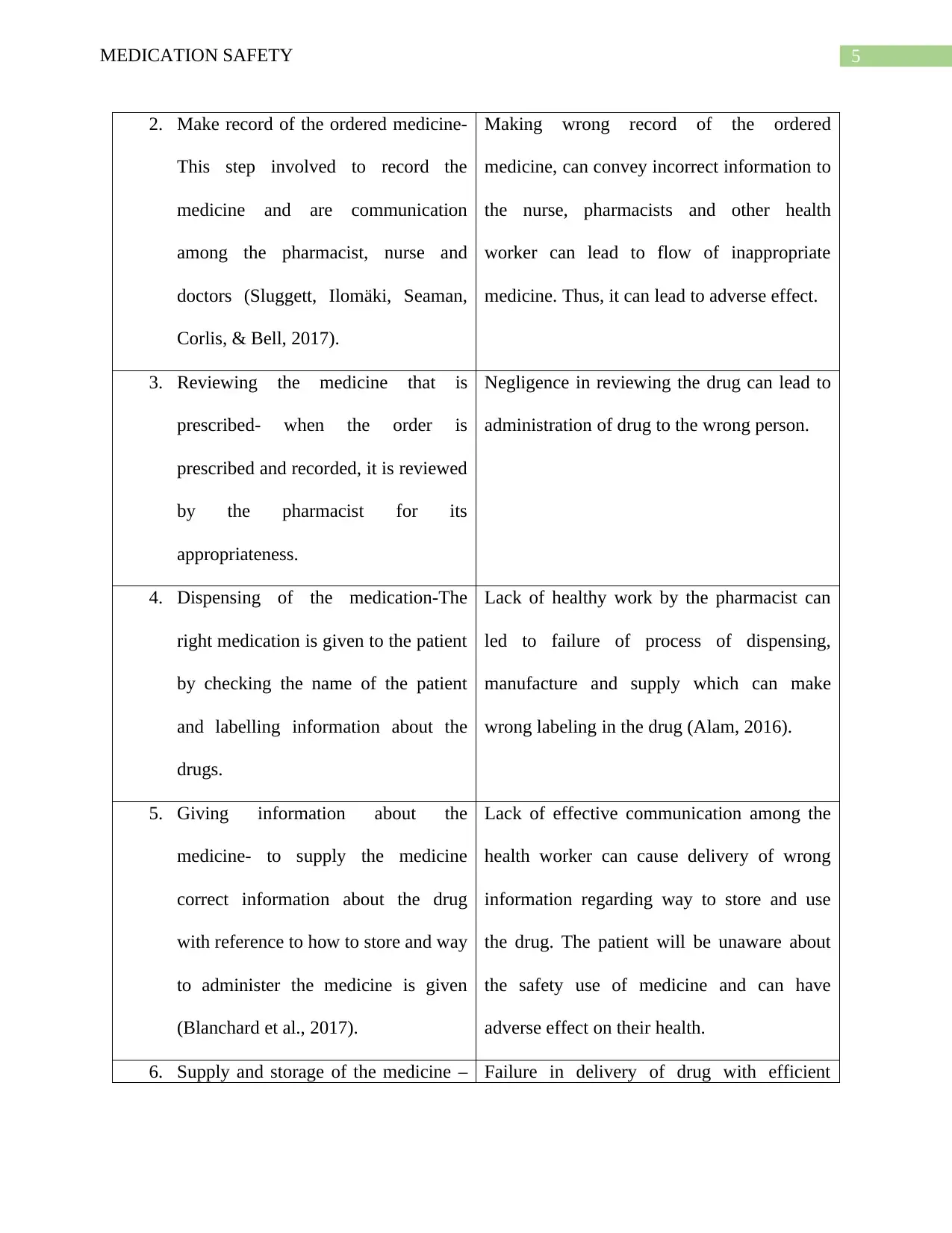
5MEDICATION SAFETY
2. Make record of the ordered medicine-
This step involved to record the
medicine and are communication
among the pharmacist, nurse and
doctors (Sluggett, Ilomäki, Seaman,
Corlis, & Bell, 2017).
Making wrong record of the ordered
medicine, can convey incorrect information to
the nurse, pharmacists and other health
worker can lead to flow of inappropriate
medicine. Thus, it can lead to adverse effect.
3. Reviewing the medicine that is
prescribed- when the order is
prescribed and recorded, it is reviewed
by the pharmacist for its
appropriateness.
Negligence in reviewing the drug can lead to
administration of drug to the wrong person.
4. Dispensing of the medication-The
right medication is given to the patient
by checking the name of the patient
and labelling information about the
drugs.
Lack of healthy work by the pharmacist can
led to failure of process of dispensing,
manufacture and supply which can make
wrong labeling in the drug (Alam, 2016).
5. Giving information about the
medicine- to supply the medicine
correct information about the drug
with reference to how to store and way
to administer the medicine is given
(Blanchard et al., 2017).
Lack of effective communication among the
health worker can cause delivery of wrong
information regarding way to store and use
the drug. The patient will be unaware about
the safety use of medicine and can have
adverse effect on their health.
6. Supply and storage of the medicine – Failure in delivery of drug with efficient
2. Make record of the ordered medicine-
This step involved to record the
medicine and are communication
among the pharmacist, nurse and
doctors (Sluggett, Ilomäki, Seaman,
Corlis, & Bell, 2017).
Making wrong record of the ordered
medicine, can convey incorrect information to
the nurse, pharmacists and other health
worker can lead to flow of inappropriate
medicine. Thus, it can lead to adverse effect.
3. Reviewing the medicine that is
prescribed- when the order is
prescribed and recorded, it is reviewed
by the pharmacist for its
appropriateness.
Negligence in reviewing the drug can lead to
administration of drug to the wrong person.
4. Dispensing of the medication-The
right medication is given to the patient
by checking the name of the patient
and labelling information about the
drugs.
Lack of healthy work by the pharmacist can
led to failure of process of dispensing,
manufacture and supply which can make
wrong labeling in the drug (Alam, 2016).
5. Giving information about the
medicine- to supply the medicine
correct information about the drug
with reference to how to store and way
to administer the medicine is given
(Blanchard et al., 2017).
Lack of effective communication among the
health worker can cause delivery of wrong
information regarding way to store and use
the drug. The patient will be unaware about
the safety use of medicine and can have
adverse effect on their health.
6. Supply and storage of the medicine – Failure in delivery of drug with efficient
⊘ This is a preview!⊘
Do you want full access?
Subscribe today to unlock all pages.

Trusted by 1+ million students worldwide
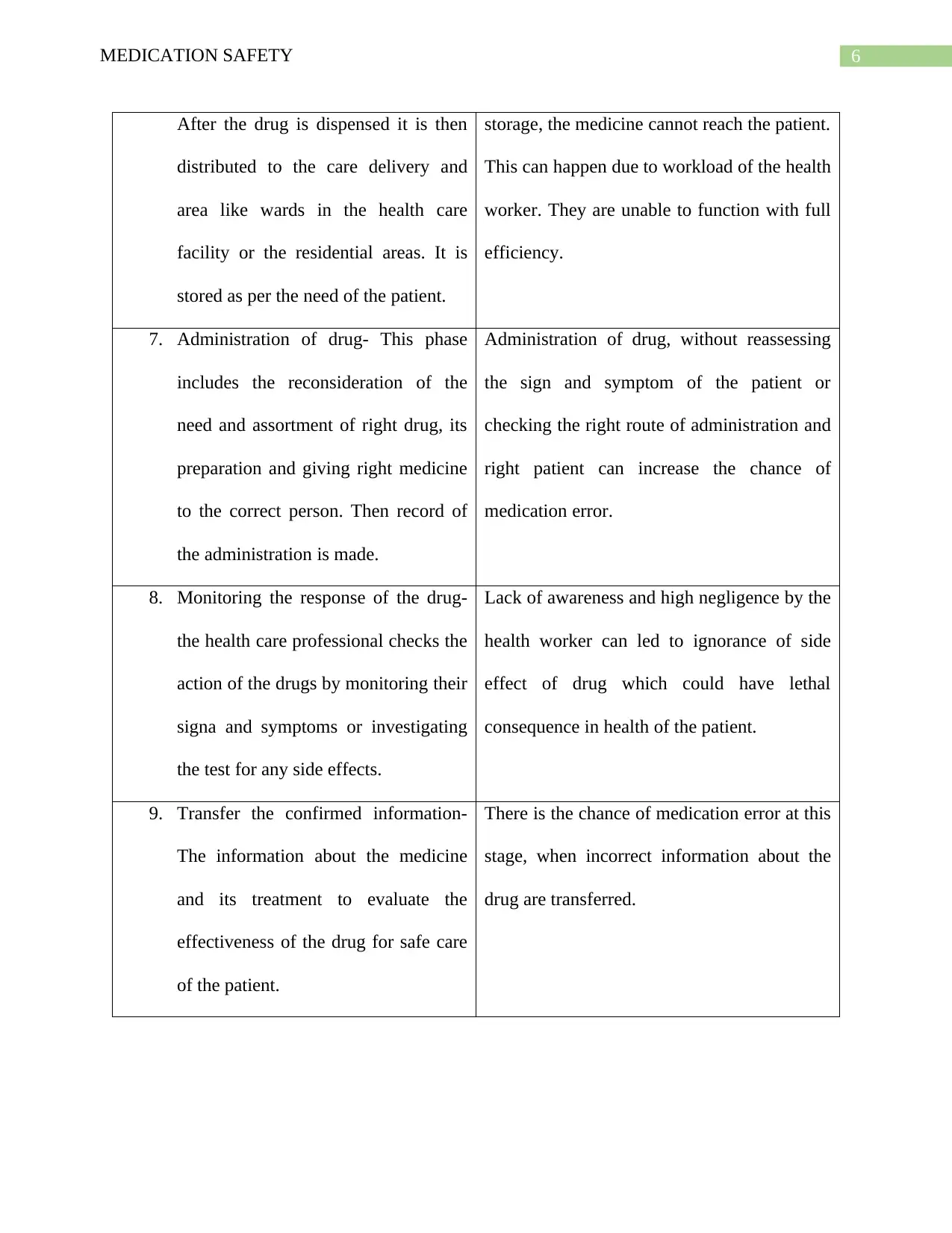
6MEDICATION SAFETY
After the drug is dispensed it is then
distributed to the care delivery and
area like wards in the health care
facility or the residential areas. It is
stored as per the need of the patient.
storage, the medicine cannot reach the patient.
This can happen due to workload of the health
worker. They are unable to function with full
efficiency.
7. Administration of drug- This phase
includes the reconsideration of the
need and assortment of right drug, its
preparation and giving right medicine
to the correct person. Then record of
the administration is made.
Administration of drug, without reassessing
the sign and symptom of the patient or
checking the right route of administration and
right patient can increase the chance of
medication error.
8. Monitoring the response of the drug-
the health care professional checks the
action of the drugs by monitoring their
signa and symptoms or investigating
the test for any side effects.
Lack of awareness and high negligence by the
health worker can led to ignorance of side
effect of drug which could have lethal
consequence in health of the patient.
9. Transfer the confirmed information-
The information about the medicine
and its treatment to evaluate the
effectiveness of the drug for safe care
of the patient.
There is the chance of medication error at this
stage, when incorrect information about the
drug are transferred.
After the drug is dispensed it is then
distributed to the care delivery and
area like wards in the health care
facility or the residential areas. It is
stored as per the need of the patient.
storage, the medicine cannot reach the patient.
This can happen due to workload of the health
worker. They are unable to function with full
efficiency.
7. Administration of drug- This phase
includes the reconsideration of the
need and assortment of right drug, its
preparation and giving right medicine
to the correct person. Then record of
the administration is made.
Administration of drug, without reassessing
the sign and symptom of the patient or
checking the right route of administration and
right patient can increase the chance of
medication error.
8. Monitoring the response of the drug-
the health care professional checks the
action of the drugs by monitoring their
signa and symptoms or investigating
the test for any side effects.
Lack of awareness and high negligence by the
health worker can led to ignorance of side
effect of drug which could have lethal
consequence in health of the patient.
9. Transfer the confirmed information-
The information about the medicine
and its treatment to evaluate the
effectiveness of the drug for safe care
of the patient.
There is the chance of medication error at this
stage, when incorrect information about the
drug are transferred.
Paraphrase This Document
Need a fresh take? Get an instant paraphrase of this document with our AI Paraphraser
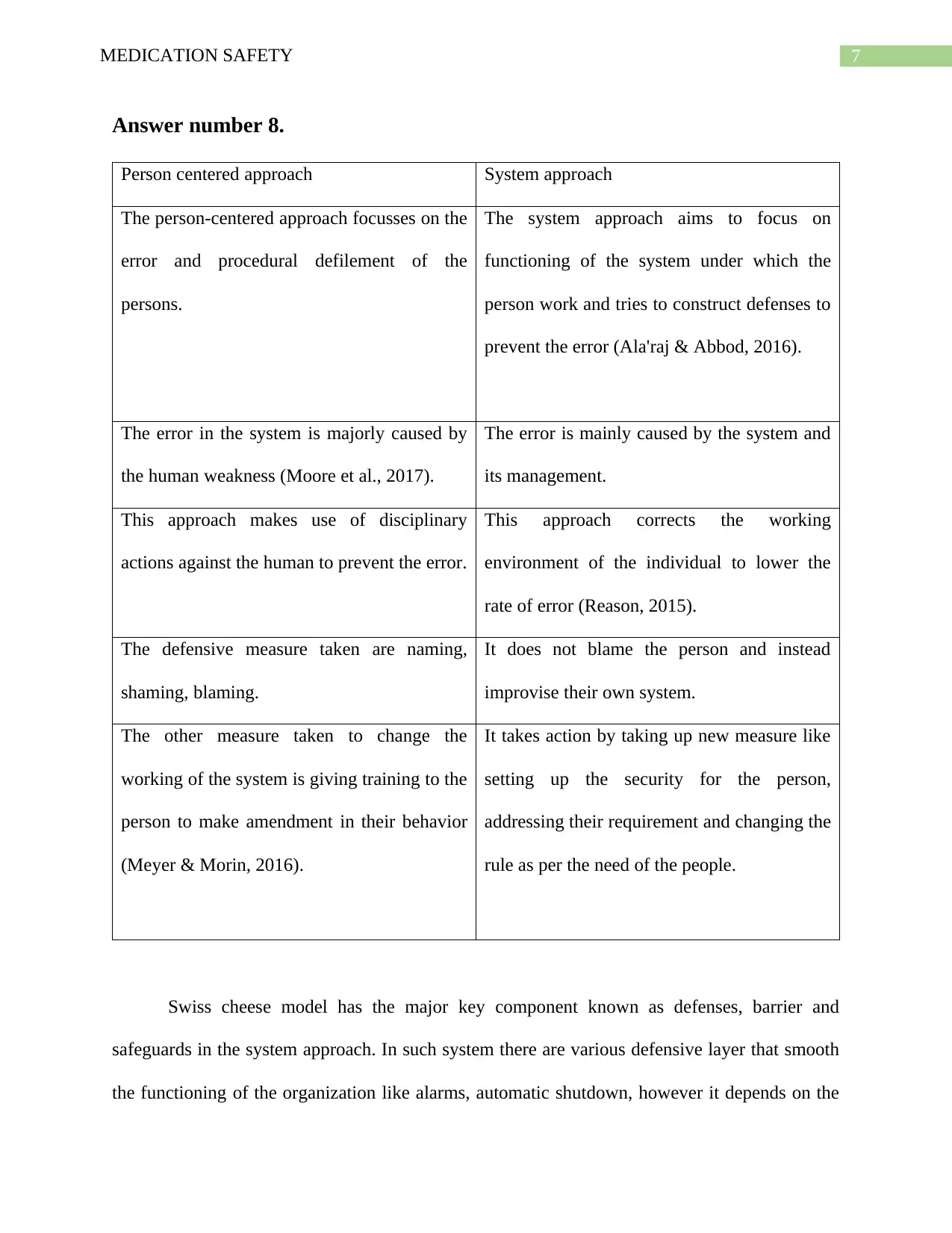
7MEDICATION SAFETY
Answer number 8.
Person centered approach System approach
The person-centered approach focusses on the
error and procedural defilement of the
persons.
The system approach aims to focus on
functioning of the system under which the
person work and tries to construct defenses to
prevent the error (Ala'raj & Abbod, 2016).
The error in the system is majorly caused by
the human weakness (Moore et al., 2017).
The error is mainly caused by the system and
its management.
This approach makes use of disciplinary
actions against the human to prevent the error.
This approach corrects the working
environment of the individual to lower the
rate of error (Reason, 2015).
The defensive measure taken are naming,
shaming, blaming.
It does not blame the person and instead
improvise their own system.
The other measure taken to change the
working of the system is giving training to the
person to make amendment in their behavior
(Meyer & Morin, 2016).
It takes action by taking up new measure like
setting up the security for the person,
addressing their requirement and changing the
rule as per the need of the people.
Swiss cheese model has the major key component known as defenses, barrier and
safeguards in the system approach. In such system there are various defensive layer that smooth
the functioning of the organization like alarms, automatic shutdown, however it depends on the
Answer number 8.
Person centered approach System approach
The person-centered approach focusses on the
error and procedural defilement of the
persons.
The system approach aims to focus on
functioning of the system under which the
person work and tries to construct defenses to
prevent the error (Ala'raj & Abbod, 2016).
The error in the system is majorly caused by
the human weakness (Moore et al., 2017).
The error is mainly caused by the system and
its management.
This approach makes use of disciplinary
actions against the human to prevent the error.
This approach corrects the working
environment of the individual to lower the
rate of error (Reason, 2015).
The defensive measure taken are naming,
shaming, blaming.
It does not blame the person and instead
improvise their own system.
The other measure taken to change the
working of the system is giving training to the
person to make amendment in their behavior
(Meyer & Morin, 2016).
It takes action by taking up new measure like
setting up the security for the person,
addressing their requirement and changing the
rule as per the need of the people.
Swiss cheese model has the major key component known as defenses, barrier and
safeguards in the system approach. In such system there are various defensive layer that smooth
the functioning of the organization like alarms, automatic shutdown, however it depends on the
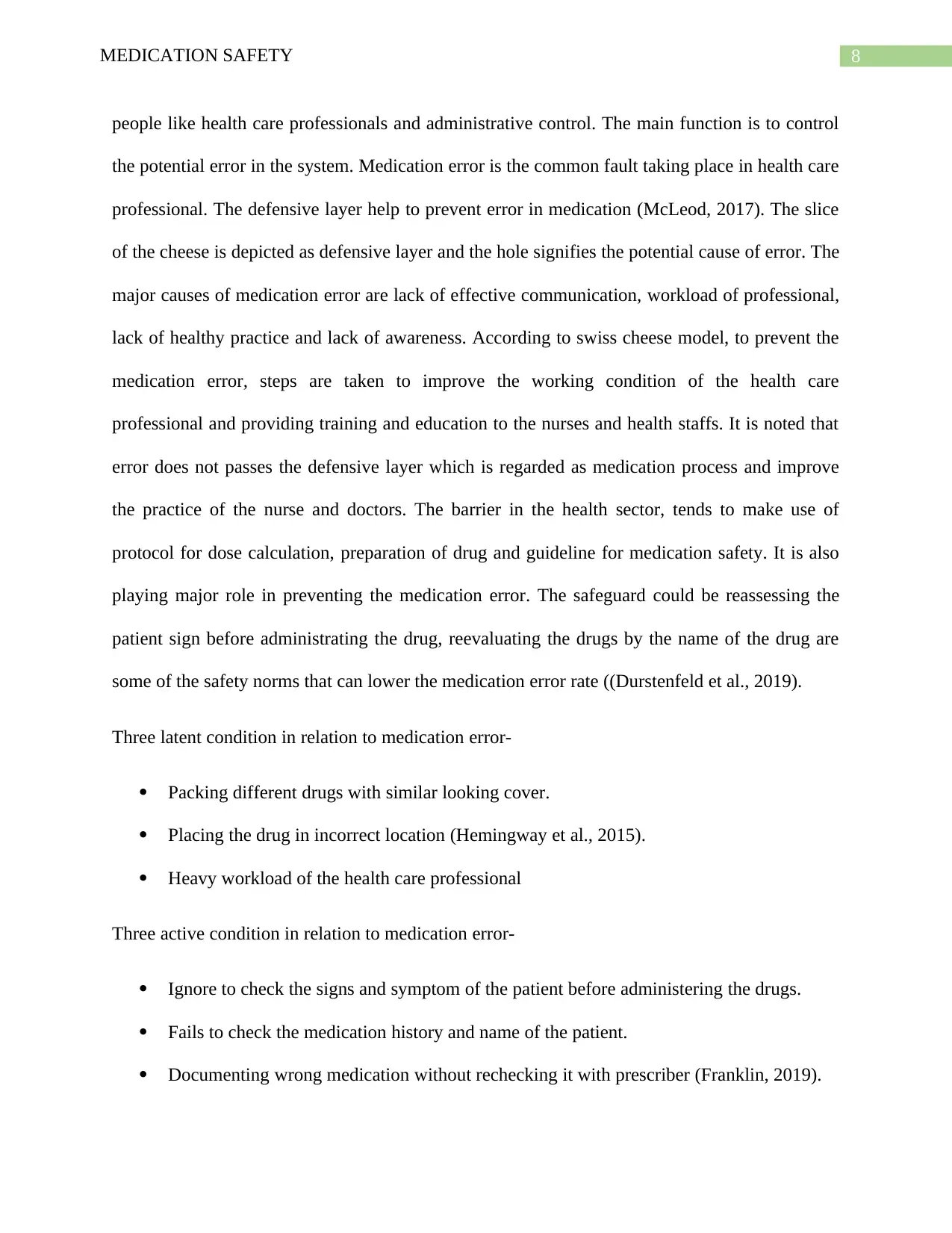
8MEDICATION SAFETY
people like health care professionals and administrative control. The main function is to control
the potential error in the system. Medication error is the common fault taking place in health care
professional. The defensive layer help to prevent error in medication (McLeod, 2017). The slice
of the cheese is depicted as defensive layer and the hole signifies the potential cause of error. The
major causes of medication error are lack of effective communication, workload of professional,
lack of healthy practice and lack of awareness. According to swiss cheese model, to prevent the
medication error, steps are taken to improve the working condition of the health care
professional and providing training and education to the nurses and health staffs. It is noted that
error does not passes the defensive layer which is regarded as medication process and improve
the practice of the nurse and doctors. The barrier in the health sector, tends to make use of
protocol for dose calculation, preparation of drug and guideline for medication safety. It is also
playing major role in preventing the medication error. The safeguard could be reassessing the
patient sign before administrating the drug, reevaluating the drugs by the name of the drug are
some of the safety norms that can lower the medication error rate ((Durstenfeld et al., 2019).
Three latent condition in relation to medication error-
Packing different drugs with similar looking cover.
Placing the drug in incorrect location (Hemingway et al., 2015).
Heavy workload of the health care professional
Three active condition in relation to medication error-
Ignore to check the signs and symptom of the patient before administering the drugs.
Fails to check the medication history and name of the patient.
Documenting wrong medication without rechecking it with prescriber (Franklin, 2019).
people like health care professionals and administrative control. The main function is to control
the potential error in the system. Medication error is the common fault taking place in health care
professional. The defensive layer help to prevent error in medication (McLeod, 2017). The slice
of the cheese is depicted as defensive layer and the hole signifies the potential cause of error. The
major causes of medication error are lack of effective communication, workload of professional,
lack of healthy practice and lack of awareness. According to swiss cheese model, to prevent the
medication error, steps are taken to improve the working condition of the health care
professional and providing training and education to the nurses and health staffs. It is noted that
error does not passes the defensive layer which is regarded as medication process and improve
the practice of the nurse and doctors. The barrier in the health sector, tends to make use of
protocol for dose calculation, preparation of drug and guideline for medication safety. It is also
playing major role in preventing the medication error. The safeguard could be reassessing the
patient sign before administrating the drug, reevaluating the drugs by the name of the drug are
some of the safety norms that can lower the medication error rate ((Durstenfeld et al., 2019).
Three latent condition in relation to medication error-
Packing different drugs with similar looking cover.
Placing the drug in incorrect location (Hemingway et al., 2015).
Heavy workload of the health care professional
Three active condition in relation to medication error-
Ignore to check the signs and symptom of the patient before administering the drugs.
Fails to check the medication history and name of the patient.
Documenting wrong medication without rechecking it with prescriber (Franklin, 2019).
⊘ This is a preview!⊘
Do you want full access?
Subscribe today to unlock all pages.

Trusted by 1+ million students worldwide
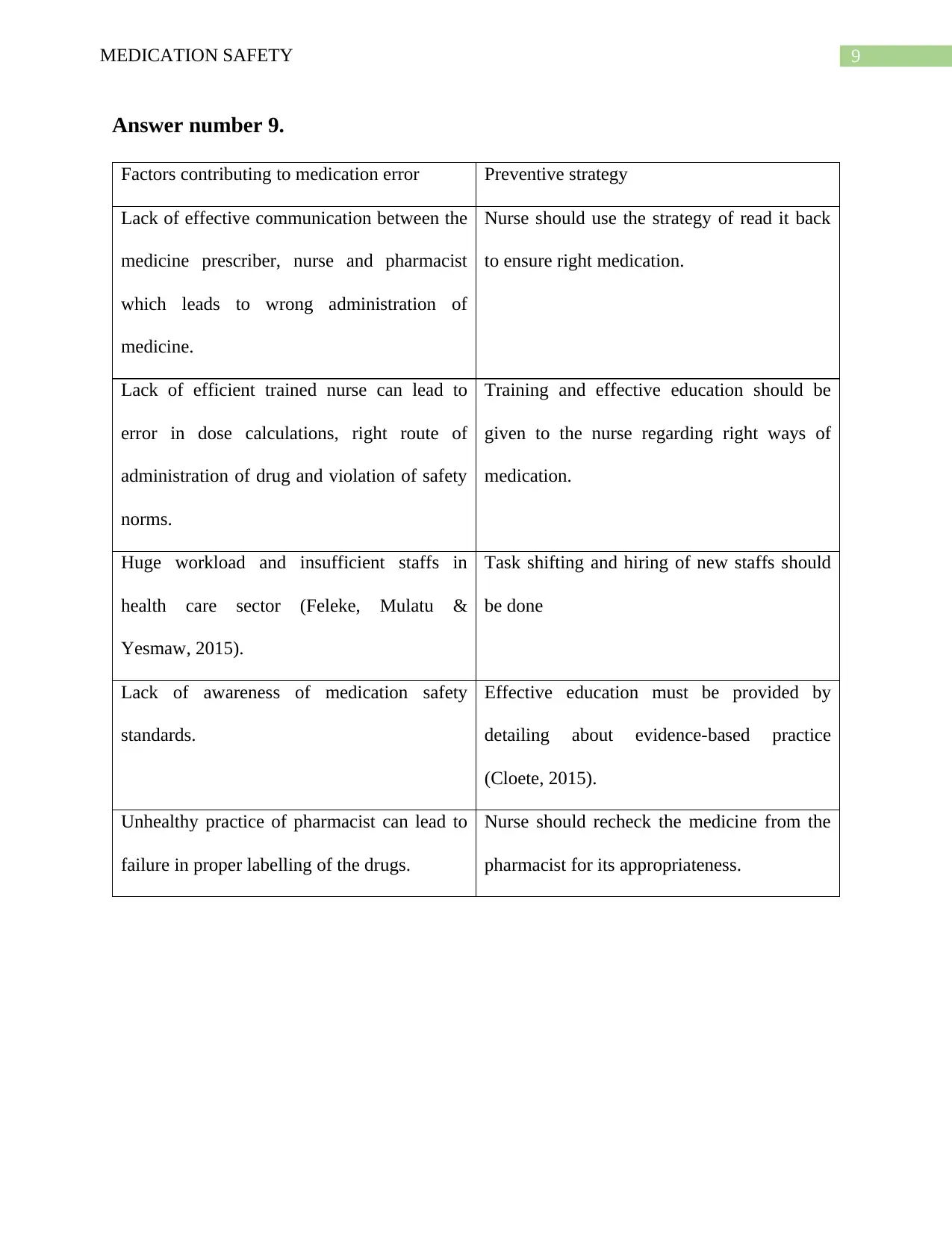
9MEDICATION SAFETY
Answer number 9.
Factors contributing to medication error Preventive strategy
Lack of effective communication between the
medicine prescriber, nurse and pharmacist
which leads to wrong administration of
medicine.
Nurse should use the strategy of read it back
to ensure right medication.
Lack of efficient trained nurse can lead to
error in dose calculations, right route of
administration of drug and violation of safety
norms.
Training and effective education should be
given to the nurse regarding right ways of
medication.
Huge workload and insufficient staffs in
health care sector (Feleke, Mulatu &
Yesmaw, 2015).
Task shifting and hiring of new staffs should
be done
Lack of awareness of medication safety
standards.
Effective education must be provided by
detailing about evidence-based practice
(Cloete, 2015).
Unhealthy practice of pharmacist can lead to
failure in proper labelling of the drugs.
Nurse should recheck the medicine from the
pharmacist for its appropriateness.
Answer number 9.
Factors contributing to medication error Preventive strategy
Lack of effective communication between the
medicine prescriber, nurse and pharmacist
which leads to wrong administration of
medicine.
Nurse should use the strategy of read it back
to ensure right medication.
Lack of efficient trained nurse can lead to
error in dose calculations, right route of
administration of drug and violation of safety
norms.
Training and effective education should be
given to the nurse regarding right ways of
medication.
Huge workload and insufficient staffs in
health care sector (Feleke, Mulatu &
Yesmaw, 2015).
Task shifting and hiring of new staffs should
be done
Lack of awareness of medication safety
standards.
Effective education must be provided by
detailing about evidence-based practice
(Cloete, 2015).
Unhealthy practice of pharmacist can lead to
failure in proper labelling of the drugs.
Nurse should recheck the medicine from the
pharmacist for its appropriateness.
Paraphrase This Document
Need a fresh take? Get an instant paraphrase of this document with our AI Paraphraser
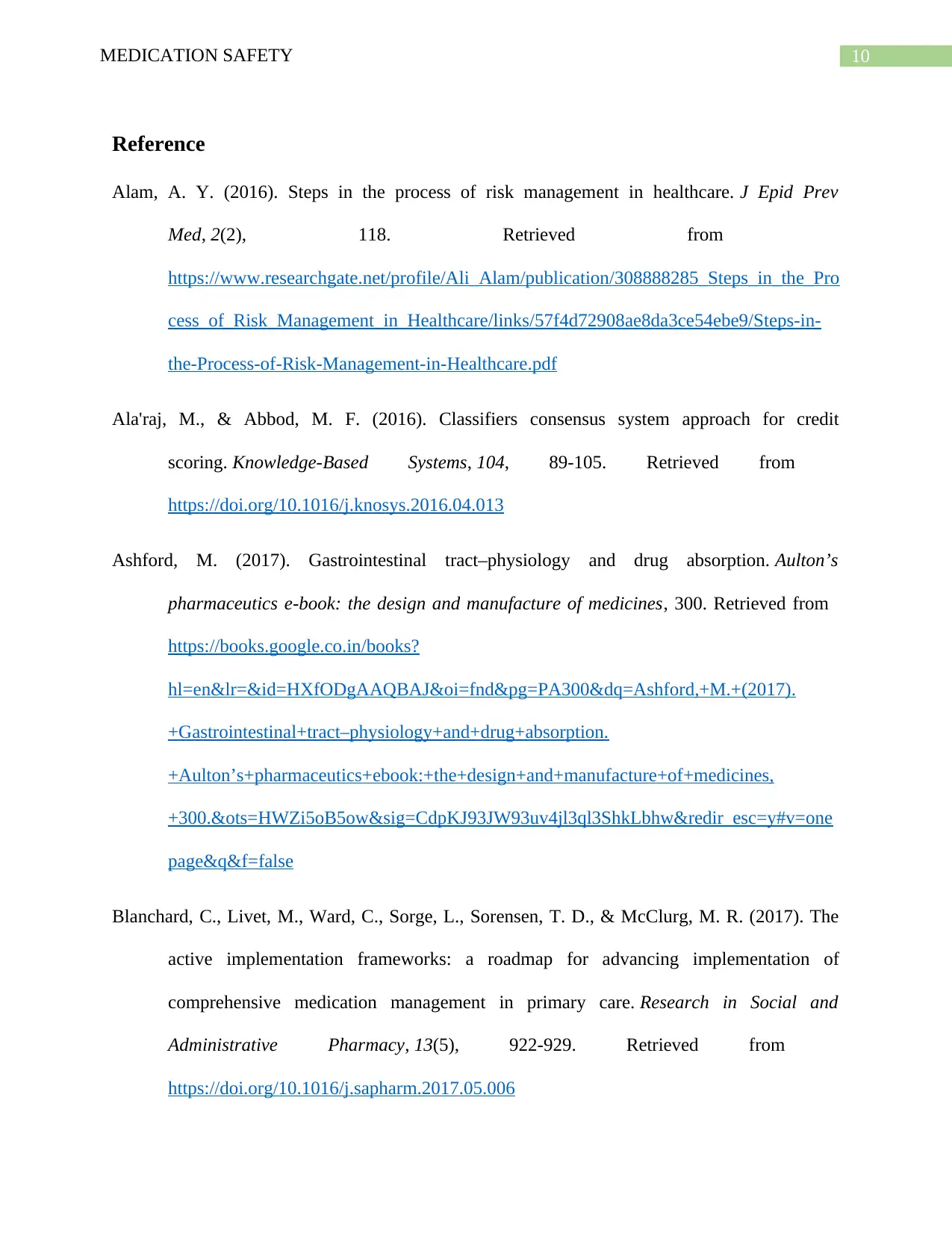
10MEDICATION SAFETY
Reference
Alam, A. Y. (2016). Steps in the process of risk management in healthcare. J Epid Prev
Med, 2(2), 118. Retrieved from
https://www.researchgate.net/profile/Ali_Alam/publication/308888285_Steps_in_the_Pro
cess_of_Risk_Management_in_Healthcare/links/57f4d72908ae8da3ce54ebe9/Steps-in-
the-Process-of-Risk-Management-in-Healthcare.pdf
Ala'raj, M., & Abbod, M. F. (2016). Classifiers consensus system approach for credit
scoring. Knowledge-Based Systems, 104, 89-105. Retrieved from
https://doi.org/10.1016/j.knosys.2016.04.013
Ashford, M. (2017). Gastrointestinal tract–physiology and drug absorption. Aulton’s
pharmaceutics e-book: the design and manufacture of medicines, 300. Retrieved from
https://books.google.co.in/books?
hl=en&lr=&id=HXfODgAAQBAJ&oi=fnd&pg=PA300&dq=Ashford,+M.+(2017).
+Gastrointestinal+tract–physiology+and+drug+absorption.
+Aulton’s+pharmaceutics+ebook:+the+design+and+manufacture+of+medicines,
+300.&ots=HWZi5oB5ow&sig=CdpKJ93JW93uv4jl3ql3ShkLbhw&redir_esc=y#v=one
page&q&f=false
Blanchard, C., Livet, M., Ward, C., Sorge, L., Sorensen, T. D., & McClurg, M. R. (2017). The
active implementation frameworks: a roadmap for advancing implementation of
comprehensive medication management in primary care. Research in Social and
Administrative Pharmacy, 13(5), 922-929. Retrieved from
https://doi.org/10.1016/j.sapharm.2017.05.006
Reference
Alam, A. Y. (2016). Steps in the process of risk management in healthcare. J Epid Prev
Med, 2(2), 118. Retrieved from
https://www.researchgate.net/profile/Ali_Alam/publication/308888285_Steps_in_the_Pro
cess_of_Risk_Management_in_Healthcare/links/57f4d72908ae8da3ce54ebe9/Steps-in-
the-Process-of-Risk-Management-in-Healthcare.pdf
Ala'raj, M., & Abbod, M. F. (2016). Classifiers consensus system approach for credit
scoring. Knowledge-Based Systems, 104, 89-105. Retrieved from
https://doi.org/10.1016/j.knosys.2016.04.013
Ashford, M. (2017). Gastrointestinal tract–physiology and drug absorption. Aulton’s
pharmaceutics e-book: the design and manufacture of medicines, 300. Retrieved from
https://books.google.co.in/books?
hl=en&lr=&id=HXfODgAAQBAJ&oi=fnd&pg=PA300&dq=Ashford,+M.+(2017).
+Gastrointestinal+tract–physiology+and+drug+absorption.
+Aulton’s+pharmaceutics+ebook:+the+design+and+manufacture+of+medicines,
+300.&ots=HWZi5oB5ow&sig=CdpKJ93JW93uv4jl3ql3ShkLbhw&redir_esc=y#v=one
page&q&f=false
Blanchard, C., Livet, M., Ward, C., Sorge, L., Sorensen, T. D., & McClurg, M. R. (2017). The
active implementation frameworks: a roadmap for advancing implementation of
comprehensive medication management in primary care. Research in Social and
Administrative Pharmacy, 13(5), 922-929. Retrieved from
https://doi.org/10.1016/j.sapharm.2017.05.006
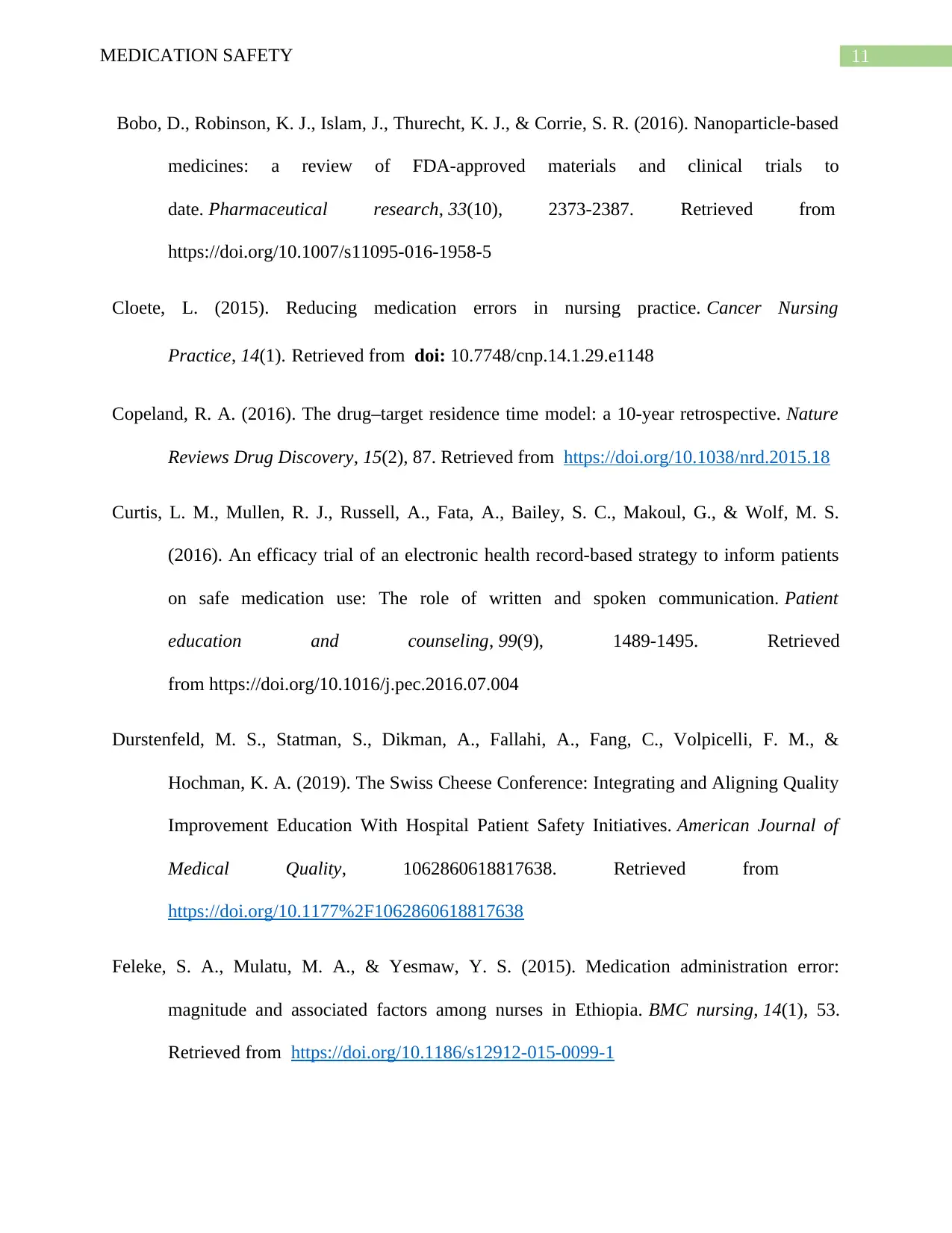
11MEDICATION SAFETY
Bobo, D., Robinson, K. J., Islam, J., Thurecht, K. J., & Corrie, S. R. (2016). Nanoparticle-based
medicines: a review of FDA-approved materials and clinical trials to
date. Pharmaceutical research, 33(10), 2373-2387. Retrieved from
https://doi.org/10.1007/s11095-016-1958-5
Cloete, L. (2015). Reducing medication errors in nursing practice. Cancer Nursing
Practice, 14(1). Retrieved from doi: 10.7748/cnp.14.1.29.e1148
Copeland, R. A. (2016). The drug–target residence time model: a 10-year retrospective. Nature
Reviews Drug Discovery, 15(2), 87. Retrieved from https://doi.org/10.1038/nrd.2015.18
Curtis, L. M., Mullen, R. J., Russell, A., Fata, A., Bailey, S. C., Makoul, G., & Wolf, M. S.
(2016). An efficacy trial of an electronic health record-based strategy to inform patients
on safe medication use: The role of written and spoken communication. Patient
education and counseling, 99(9), 1489-1495. Retrieved
from https://doi.org/10.1016/j.pec.2016.07.004
Durstenfeld, M. S., Statman, S., Dikman, A., Fallahi, A., Fang, C., Volpicelli, F. M., &
Hochman, K. A. (2019). The Swiss Cheese Conference: Integrating and Aligning Quality
Improvement Education With Hospital Patient Safety Initiatives. American Journal of
Medical Quality, 1062860618817638. Retrieved from
https://doi.org/10.1177%2F1062860618817638
Feleke, S. A., Mulatu, M. A., & Yesmaw, Y. S. (2015). Medication administration error:
magnitude and associated factors among nurses in Ethiopia. BMC nursing, 14(1), 53.
Retrieved from https://doi.org/10.1186/s12912-015-0099-1
Bobo, D., Robinson, K. J., Islam, J., Thurecht, K. J., & Corrie, S. R. (2016). Nanoparticle-based
medicines: a review of FDA-approved materials and clinical trials to
date. Pharmaceutical research, 33(10), 2373-2387. Retrieved from
https://doi.org/10.1007/s11095-016-1958-5
Cloete, L. (2015). Reducing medication errors in nursing practice. Cancer Nursing
Practice, 14(1). Retrieved from doi: 10.7748/cnp.14.1.29.e1148
Copeland, R. A. (2016). The drug–target residence time model: a 10-year retrospective. Nature
Reviews Drug Discovery, 15(2), 87. Retrieved from https://doi.org/10.1038/nrd.2015.18
Curtis, L. M., Mullen, R. J., Russell, A., Fata, A., Bailey, S. C., Makoul, G., & Wolf, M. S.
(2016). An efficacy trial of an electronic health record-based strategy to inform patients
on safe medication use: The role of written and spoken communication. Patient
education and counseling, 99(9), 1489-1495. Retrieved
from https://doi.org/10.1016/j.pec.2016.07.004
Durstenfeld, M. S., Statman, S., Dikman, A., Fallahi, A., Fang, C., Volpicelli, F. M., &
Hochman, K. A. (2019). The Swiss Cheese Conference: Integrating and Aligning Quality
Improvement Education With Hospital Patient Safety Initiatives. American Journal of
Medical Quality, 1062860618817638. Retrieved from
https://doi.org/10.1177%2F1062860618817638
Feleke, S. A., Mulatu, M. A., & Yesmaw, Y. S. (2015). Medication administration error:
magnitude and associated factors among nurses in Ethiopia. BMC nursing, 14(1), 53.
Retrieved from https://doi.org/10.1186/s12912-015-0099-1
⊘ This is a preview!⊘
Do you want full access?
Subscribe today to unlock all pages.

Trusted by 1+ million students worldwide
1 out of 15
Related Documents
Your All-in-One AI-Powered Toolkit for Academic Success.
+13062052269
info@desklib.com
Available 24*7 on WhatsApp / Email
![[object Object]](/_next/static/media/star-bottom.7253800d.svg)
Unlock your academic potential
Copyright © 2020–2025 A2Z Services. All Rights Reserved. Developed and managed by ZUCOL.





